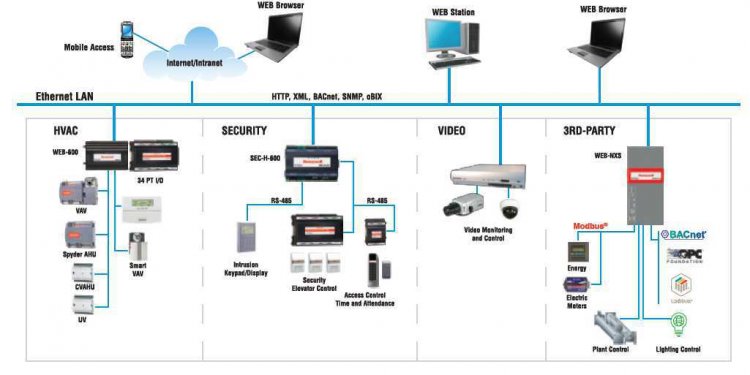
Building Access Control Systems
Editor's note: ADT recently announced the completion of a merger with Protection 1. When ADT and Protection 1 complete this brand integration, we will update our access control systems reviews to reflect that information.
The top performers in our review are Protection 1, the Gold Award winner; Tyco, the Silver Award winner; and Brivo, the Bronze Award winner. Here’s more on choosing a blog platform to meet your needs, along with detail on how we arrived at our ranking of 10 options.
When it comes to keeping your business and employees secure, access control is the most efficient way to prevent unauthorized visitors, restrict certain employees from accessing sensitive areas and managing your employees’ access.
Rather than giving each of your employees a set of keys to your business, you can opt to connect your doors to an access control system, letting your employees access the business using specialized credentials, such as a key card, that they input into a reader to unlock the door. You can set the level of security and find the right balance between safety and convenience for you and your employees. When an employee leaves your company, simply deactivate their credentials to deny them further access.
With access control security, you know who enters your business, when they entered and what door they used. Using the report interface that comes with most access control systems, you can track where your employees are. You can also section off rooms or areas to only authorized employees and receive reports of suspicious activity, such as someone trying to get into somewhere they don’t belong.
Access Control: Traditional vs. IP Systems
There are two prominent types of access control systems. The first is the traditional method of access control where control panels act as hubs for door readers, door locks, cameras and the system’s interface, usually a PC. The door readers and control panels connect with proprietary power and communication wiring. The second, newer method of access control is called an IP system. This type of system connects the door readers directly to a network, usually through Ethernet or wireless signals. Instead of control panels, these systems run usually through a less-bulky and easier-to-install network hub.
While IP systems are newer, there is still contention in the security market over which method is better. IP systems are much simpler to set up, usually just needing Ethernet connections to your company’s network rather than serial connections to multiple control panels. There is no limit to how many door readers can be connected to an IP system, while in a traditional system, control panels can only be connected to a handful of doors, so you’d need several panels to secure buildings with many doors. Critics say IP systems are less secure than the proprietary traditional versions of access control since network outages can affect performance and they are more susceptible to hackers. Ultimately, the system that would best suit your company depends on your needs. Some access control services offer both options and will work with you to determine which type would work best.
Working with Credentials
There are three forms of authentication: a physical credential like a card or key fob, a password or PIN, and something biometric like your fingerprint. Biometric credentials have been gaining in popularity, with nearly every company on the list offering this option. Another method of authentication that is emerging is mobile phone credentials, which involves using a phone app in place of a card.
For optimal security, use at least two of these methods for authentication. This practice is known as layered security, which requires employees to go through multiple safeguards before entering your business or certain sections.
If an employee leaves the company, whether they resigned or were terminated, their credentials should be voided immediately. Most control systems have an option to instantly revoke an employee’s access and can even automatically suspend them if the system detects suspicious behavior.
Enhancing Your Security
Security professionals recommend that businesses do a yearly review of their security and access control. Consider your security needs and how your current system has served you. If there have been any security incidents over the past year, reflect on whether your current system is at fault and if it could be more secure.
As part of your company’s routine security inspections, regularly examine the hardware involved with the access control system and check door readers, along with the wiring that connects them to the system, for signs of tampering. If the system is connected to a control panel, be sure it is installed in a secure location and that it remains locked at all times.
You can enhance your security by setting up what is called an anti-passback. This means setting up a reader on both sides of a door, requiring employees to use their credentials to exit the building as well as to enter. An anti-passback system will not allow credentials to be used to enter a door twice because it detects that the user is already in the building and won’t know they’ve left until they’ve used the exit reader. This can protect against cases of copied cards, cards being passed to others after opening the door or passcodes falling into the wrong hands.
What We Evaluated, What We Found
We looked at each access control company for the features we believe are most important to your business’s access control and security. We examined the technical aspects of their products and checked to see if they offered certain services. We gathered this data by browsing these companies’ websites and contacting them anonymously to gather information and to gauge the level of customer service we received. The companies had no input on our testing, and our rankings were not shared with them prior to publication.
Security: Keep Your Employees and Your Business Safe
Security should be the most important factor when choosing an access control system. Services that offer outdated technology, cut corners or are missing key safety features, such as lockdown modes and alarms, did not score well in our evaluation. Door readers and physical credentials come in many varieties, but the best services include readers with their own memory and processors for making decisions, as well as credentials that incorporate some form of encryption. Proprietary technology, rather than open source, is more secure and less likely to be taken advantage of.
The door readers themselves should be physically secured with specialty screws, and the wiring tucked away and protected. Some readers even have tamper alarms that go off if they are physically altered or removed. Door hold alarms can alert you when select doors are held open too long. Options for different types of credentials, as well as allowing multiple credential authentication, are a must.
Crucial safety protocols include fire and carbon monoxide alerts, along with break-in alarms. In case of emergencies, you should be able to customize lockdown scenarios, programming the system to automatically open and lock selected doors on such occasions. Protection 1 and ADT do well in providing this optimal set up, easily integrating these added security features with their access control systems. While some companies on our list don’t offer these security features, they becoming increasingly standard for access control providers.

















